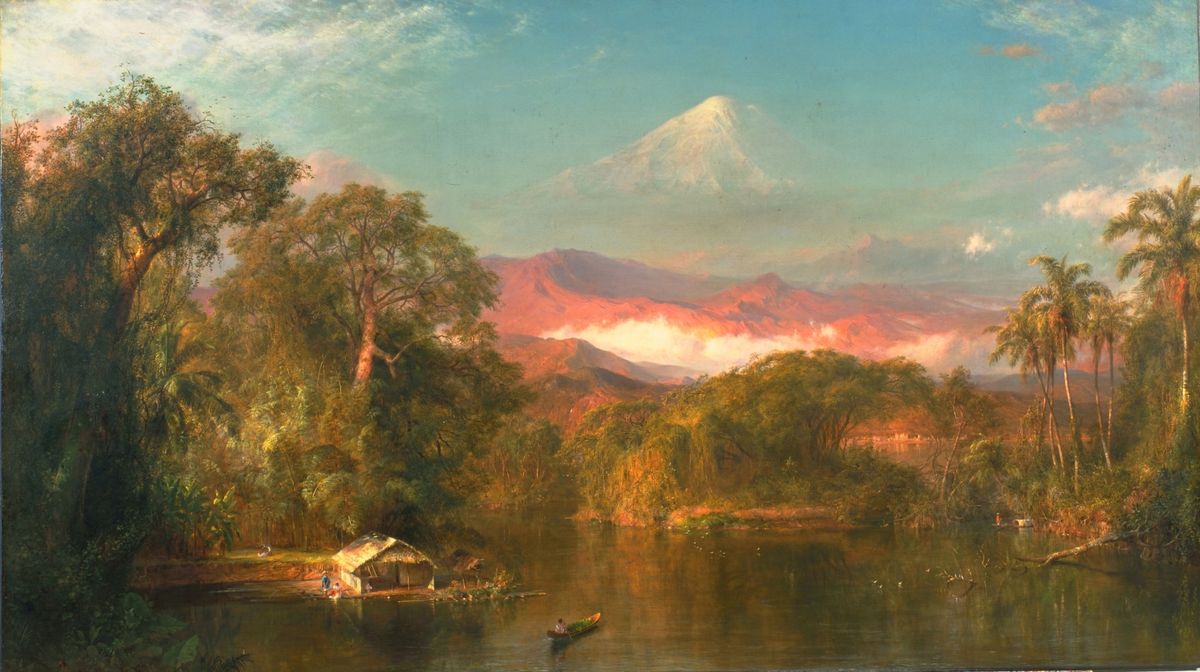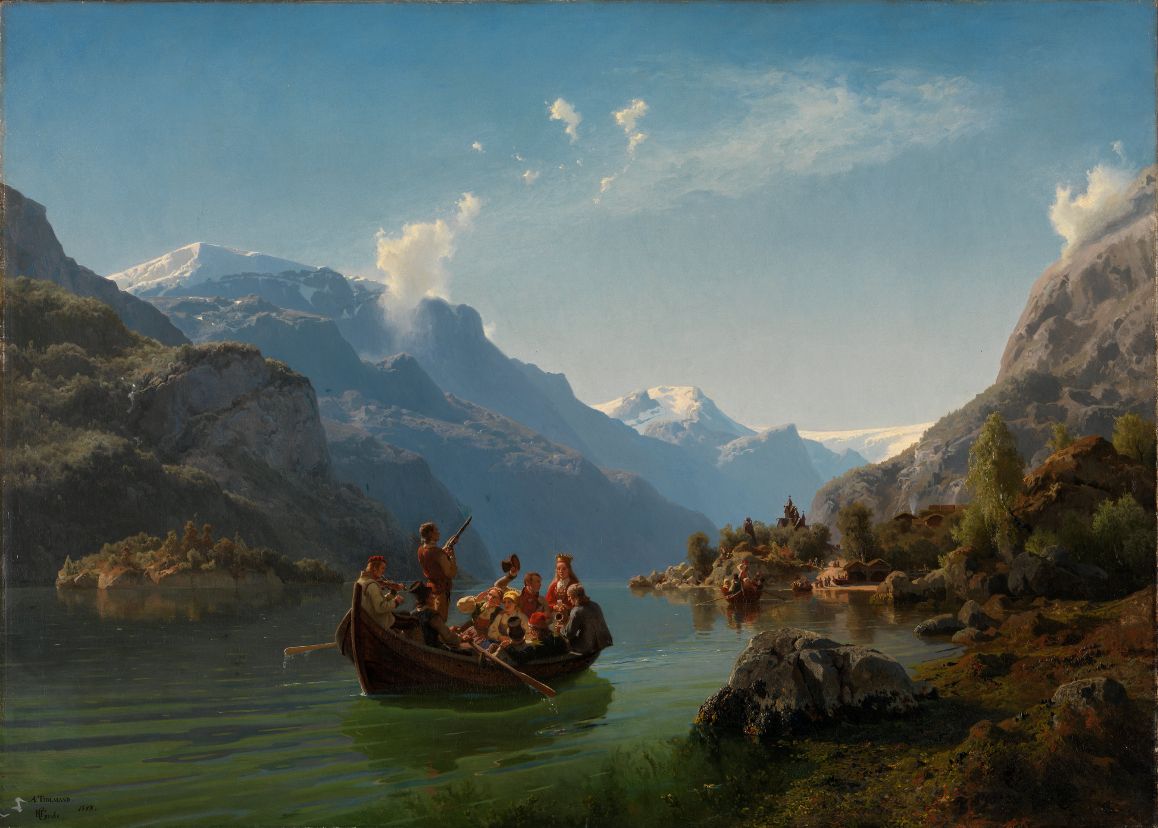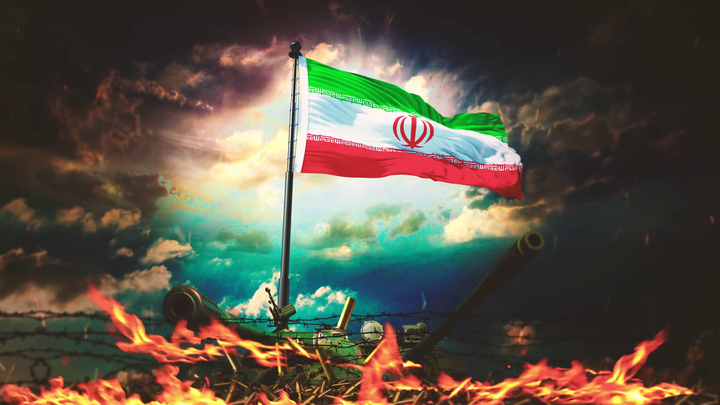"Chimborazo": the environmental romanticism of Frederic Edwin Church.
This 1864 painting is a beautiful example of Romantic-era environmental consciousness.

In June 2014, when I was on a research trip to the Huntington Library in southern California, I saw this painting at the Virginia Steele Scott Gallery of American Art and I fell in love with it immediately. It's called Chimborazo, and it was painted in 1864 by American landscape artist Frederic Edwin Church. As beautiful as the above picture file is, it doesn't do the original justice. The real painting is about 12 feet long and takes up an entire wall of the museum. The colors, especially the rose-pink of the foothills, the white of the Andes and the vivid green of the jungle plants, are so vivid they seem to glow. This looks almost more real than real life. The brush-strokes on the plants are so precise, and Church so meticulous in how he painted it, that each individual plant is accurate to the species it's supposed to be, down to the number and the shape of leaves and the flowers.
Chimborazo is a mountain in the Andes, a volcano, located in Ecuador. Frederic Edwin Church trained at the Hudson River School and plied his trade in New York, but in the 1850s went to South America looking for inspiration. Given these results I'd say he found it. For years after his return in 1857 he painted scenes he'd witnessed there, most of them mountains, jungles or other impressive landscapes tinged with romanticism, which was the dominant form of landscape painting in the mid-19th century. But Church also brought another element to his pictures, that being an environmental sensibility. Here, for example, you see river, jungle and mountain regions all bound together by tight geography, and lending a majestic, spiritual quality to the scene as a whole. The spiritual dimensions of environmentalism were very prominent at this time, especially among artists. And their work did more than just produce pretty decorative pictures: this sort of artistic environmentalism was a major factor in motivating the U.S. government, and especially Theodore Roosevelt, to establish national parks and other forms of state-sponsored conservation in the late years of the century.
Chimborazo is stunning, but it's an exemplar of a kind of art that also had problematic implications. In the mid-19th century, artists in various Western countries were using paintings to stoke nationalistic political sentiments. Showcasing the natural beauty of a particular country was a way to signify to the rest of the world that that country was important and impressive. Romantic nationalism found expression in Europe with artists, for example, like Adolph Tidemand and Hans Gude in Norway, whose 1848 painting The Bridal Procession was a direct challenge to Swedish rule over Norway, which was not an independent country unti 1905. The Bridal Procession looks an awful lot like the kind of work Frederic Edwin Church did. Painters in central Europe in the same era were highlighting natural beauty and cultural themes intended to support broader projects like German unification, achieved in 1871, or ethnic independence movements. If you see stunning mountains or pastoral peasants in a bucolic countryside in a mid-19th century painting, chances are good there's some political motive at least partially behind it.

In the United States, which at the time Church was most active was leading up to and going through its Civil War, the sort of romantic nationalism that was de rigeur was the idea of manifest destiny. That was the ideology that the U.S. was somehow destined by God to stretch from the Atlantic to Pacific, and all its lands were intended for the use and ownership of Americans (translation: white Americans). Manifest destiny was a central justification for dispossessing and exterminating Native Americans and a significant engine driving American expansion into the West. To be sure, Chimborazo is not in the United States and this painting can't really be considered itself a manifest destiny picture. Nevertheless, Church did paint some pictures you could put in that category, and he's remembered by art historians as being a significant figure in the art movement that supported it. Context, as always, is everything in history, and usually in art too.
I just love Chimborazo. It's a validation of all the reasons why I think works of art from the past are important and gratifying. Now you've seen it too, and I hope your day is a little brighter for it.
The Value Proposition
Why should you be reading this blog, or receiving it as a newsletter? This is why.
☕ If you appreciate what I do, buy me a virtual coffee from time-to-time to support my work. I know it seems small, but it truly helps.
📖 You could also buy my newest book.
🎓 Like learning? Find out what courses I’m currently offering at my website.
📽 More the visual type? Here is my YouTube channel with tons of free history videos.



Comments ()